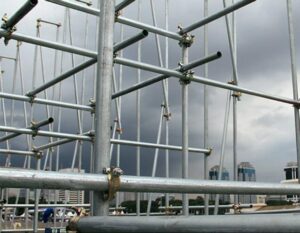
If you have ever visited a large scale city or any city under construction with large buildings and skyscrapers, you will have likely seen some of the buildings wrapped in a complex temporary structure that supports workers and assists with workload, otherwise known as scaffolding.
Scaffolding has been around since man has had the desire to build or design upwards and there are many different types of scaffolding, so choosing the right type of domestic or commercial scaffolding is imperative to the success and safety of your project.
What are some of the different types of scaffolding?
There are an array of different types of scaffolding in use in both domestic and commercial construction, all with different use cases and scenarios where they best apply, some of these include:
Single Scaffolding / Bricklayers Scaffolding
Single scaffolding stands parallel to a wall of a structure by using vertical supports called standards. Ledgers, the horizontal supports, connect to the standards at an even vertical angle. The standards are firmly planted in the ground at regular intervals, typically about 2 to 2.5 metres apart and Ledgers connect the standards horizontally at every 1.2 to 1.5 metres. These ledgers are then supported by Putlogs.
Double Scaffolding / Masons Scaffolding
Unlike single scaffolding, Double scaffolding consists of two rows of scaffolding and is a widely robust and secure construction scaffolding method that is often referred to as Masons scaffolding due to its wide use in stone masonry jobs. The main reason for its popularity within stone masonry is its very difficult to put holes in the stone walls for support putlogs, hence the need for an independent self standing structure.
Suspended and/or Swing Set Scaffolding
This type of scaffolding can usually be found on the side of high rise buildings, mainly for light maintenance work and repairs or even window cleaning. Suspended scaffolding consists of a platform suspended from above by cables and stirrups on each side of the platform or a single basket with a motor full lifting up and down.
Tube and clamp scaffolding
Tube and clamp scaffold is a versatile type of scaffold consisting of steel or aluminium tubes and clamps, as the name suggests.
One of the primary reasons why tube and clamp scaffolding is a popular choice for an array of construction work is its versatility and flexibility. The scaffolding system can be easily adjusted and customised to fit various building shapes and sizes, as well as different construction requirements.
This flexibility allows tube and clamp scaffolding to be used in a wide range of applications, from simple domestic projects to more complex commercial and industrial structures.

So what is the difference between commercial and domestic scaffolding?
In the ever changing world of construction, scaffolding serves as a key component of safety and efficiency. Whether it’s for skyscrapers or residential projects, the choice between commercial and domestic scaffolding significantly impacts project outcomes.
Understanding the differences between the two is crucial for ensuring safety, cost-effectiveness, and productivity. Here are some of the key differences:
Scope and scale
Commercial scaffolding typically works for large-scale projects such as high-rise buildings, industrial complexes, or infrastructure development. In contrast, domestic scaffolding is tailored for smaller-scale projects like residential/domestic renovations, extensions, or maintenance work on private properties
Complexity of structures
Commercial scaffolding projects often involve complex architectural designs and diverse structural requirements, demanding specialised scaffolding solutions. On the opposite side of the spectrum, domestic scaffolding deals with simpler structures, usually houses or low-rise buildings, meaning the need for less complex scaffolding set-ups.
Budget
Commercial scaffolding projects typically entail higher budgets due to the scale, complexity, and tight safety requirements involved. However, domestic scaffolding tends to be more cost-effective, reflecting the smaller scale and simpler nature of domestic/residential projects.
Duration and time sensitivity
Commercial projects often operate on tight schedules, with significant financial implications for delays. Hence, commercial scaffolding systems prioritise rapid assembly, disassembly, and adaptability to evolving project timelines. Conversely, domestic projects may have more lenient timelines, allowing for more relaxed scaffolding schedules.


